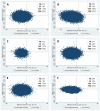Cost-Utility of the eHealth Application 'Oncokompas', Supporting Incurably Ill Cancer Patients to Self-Manage Their Cancer-Related Symptoms: Results of a Randomized Controlled Trial
- PMID: 36135055
- PMCID: PMC9497666
- DOI: 10.3390/curroncol29090486
Cost-Utility of the eHealth Application 'Oncokompas', Supporting Incurably Ill Cancer Patients to Self-Manage Their Cancer-Related Symptoms: Results of a Randomized Controlled Trial
Abstract
Evidence on the cost-effectiveness of eHealth in palliative care is scarce. Oncokompas, a fully automated behavioral intervention technology, aims to support self-management in cancer patients. This study aimed to assess the cost-utility of the eHealth application Oncokompas among incurably ill cancer patients, compared to care as usual. In this randomized controlled trial, patients were randomized into the intervention group (access to Oncokompas) or the waiting-list control group (access after three months). Healthcare costs, productivity losses, and health status were measured at baseline and three months. Intervention costs were also taken into account. Non-parametric bootstrapping with 5000 replications was used to obtain 95% confidence intervals around the incremental costs and quality-adjusted life years (QALYs). A probabilistic approach was used because of the skewness of cost data. Altogether, 138 patients completed the baseline questionnaire and were randomly assigned to the intervention group (69) or the control group (69). In the base case analysis, mean total costs and mean total effects were non-significantly lower in the intervention group (-€806 and -0.01 QALYs). The probability that the intervention was more effective and less costly was 4%, whereas the probability of being less effective and less costly was 74%. Among patients with incurable cancer, Oncokompas does not impact incremental costs and seems slightly less effective in terms of QALYs, compared to care as usual. Future research on the costs of eHealth in palliative cancer care is warranted to assess the generalizability of the findings of this study.
Keywords: cost evaluation; cost-utility analysis; eHealth; incurable cancer; palliative care; quality of life.
Conflict of interest statement
I.M.V.-d.L. reports grants from the Netherlands Organization for Health Research and Development (ZonMw), the Dutch Cancer Society (KWF Kankerbestrijding), Bristol Myers Squibb, Danone Ecofund/Nutricia. A.B.-C. reports grants from Roche. F.d.V. reports grants from Foundation STOPbraintumors.org and AbbVIe, BMS, Novartis, EORTC, Vaximm and BioClin Therapeutics. F.d.V. reports participation on a DSMB during the conduct of this study, and leaderships or fiduciary roles in other boards and commissions. F.J. reports grants from the Dutch Cancer Society (KWF Kankerbestrijding). All other authors declare no competing interests.
Figures



References
-
- Aapro M., Bossi P., Dasari A., Fallowfield L., Gascón P., Geller M., Jordan K., Kim J., Martin K., Porzig S. Digital health for optimal supportive care in oncology: Benefits, limits, and future perspectives. Support. Care Cancer. 2020;28:4589–4612. doi: 10.1007/s00520-020-05539-1. - DOI - PMC - PubMed
Publication types
MeSH terms
LinkOut - more resources
Full Text Sources
Medical

